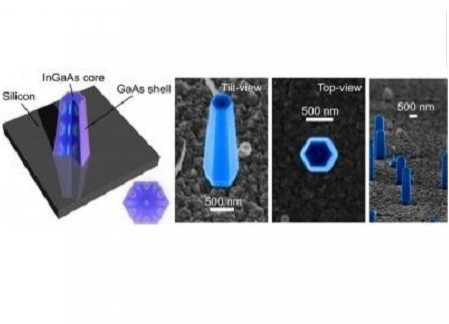Researchers Get a Step Closer to Photonic Chips

One of the barriers to ever-faster processors is the connection between the processor elements - electrons are slow and need a lot of power. Now engineers have found a way to grow the tiny lasers necessary to achieve a photonic chip, one that communicates using light waves.
By using light waves instead of electrons, computers could be not only faster, but use a lot less power. In silicon chips, more than 65 percent of the power is used in interconnections, said Professor Connie Chang-Hasnain, who led the research.
In an ordinary microprocessor, electrons can only be transmitted by wires, and there is a limit to how small they can get. Besides that, smaller wires tend to generate more heat. Gold makes a very good wire, but below a certain size gold wires would melt if the computer did too many operations per second.
Lasers would solve this problem. But one of the challenges in making them so tiny is that the crystals have to be carefully grown, and usually at high temperatures - about 650-700 degrees Celsius (1,200-1300 degrees Fahrenheit). Chang-Hasnain's team found a way to grow the tiny crystals precisely at a much lower temperature, about 400 degrees C (750 F).
The result is a crystal made of indium gallium arsenide (InGaAs) surrounded by a shell of gallium arsenide (GaAs). Each crystal is shaped like a hexagonal pylon, and is only 500 nanometers wide.
When the crystals are hit with infrared laser light, they in turn generate pulses themselves. The key, Chang-Hosnain said, is that the nanometer-size pillars generate laser light at room temperature. Other crystals have to be cooled to near absolute zero.
It is the structure of the crystal itself that causes the lasing, Chang-Hosnain said. The pillars are so tiny that they trap light efficiently and the light waves travel in a helical pattern. That pattern amplifies the light. InGaAs and GaAs are also in a class of materials that generate light very efficiently. They are both used in light-emitting diodes.
The other breakthrough is that the crystals can be made on an industrial scale without having to completely re-tool factories. The team used a vapor that is a combination of organic compounds and metals to grow the crystals on a bed of silicon. The substrate is already used in manufacturing conventional chips.
Chang-Hasnain said the next step is to try and attach waveguides to the tiny pillars, showing that the light can be sent to specific destinations and thus used to communicate between silicon-based processors. She also wants to see if other materials can produce other wavelengths. Right now the laser light is at 950 nanometers, or infrared light. But shorter wavelengths that reach into visible light can carry more information.
[InGaAs and GaAs] are very efficient light-emitting materials, Chang-Hosnain said. Silicon is not very efficient. But it is very good for computing. It's the perfect marriage.
To contact the reporter responsible for this story call (646) 461 6917 or email j.emspak@ibtimes.com.
© Copyright IBTimes 2024. All rights reserved.





















